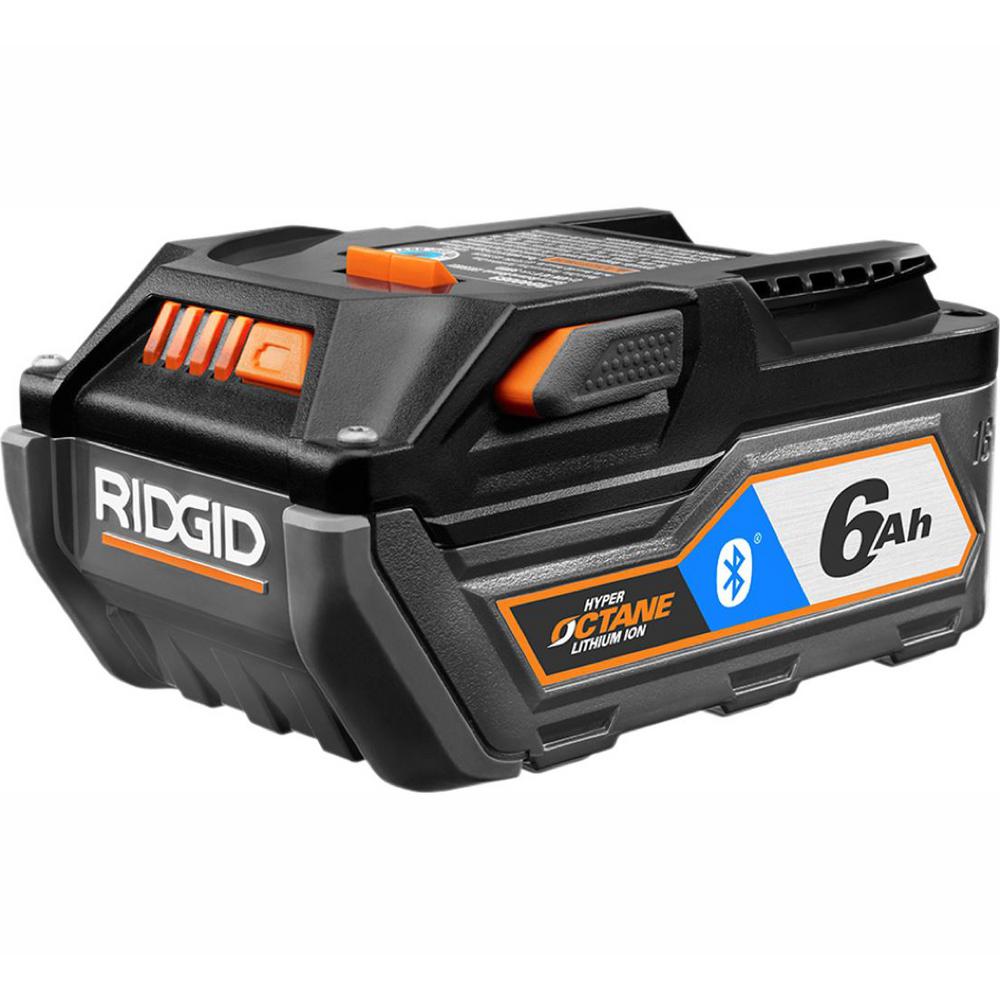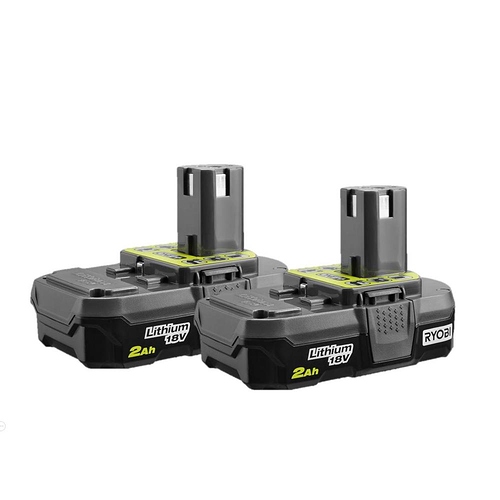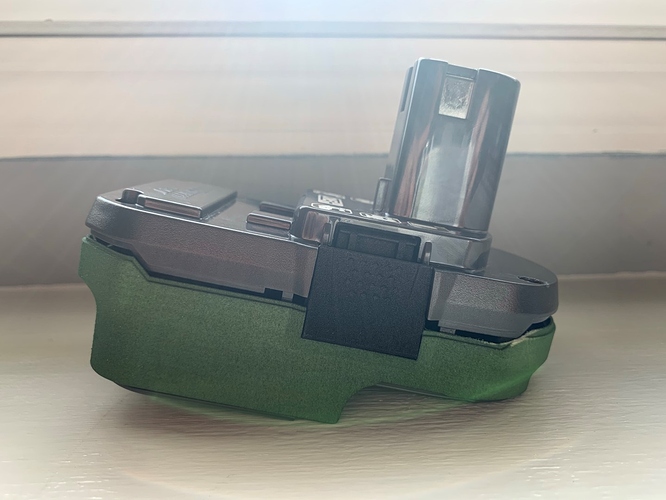Hi Greg,
Ripping out the cells would be a lot more invasive than this design.
My research suggests virtually all current power tools use the same basic battery cells as a starting point. I can’t recall the exact part number right now but the cell details are widely documented. What is different about each power tool vendor is what, if any, over current/over heat etc. circuitry they have and what the target output voltage is. Higher voltage batteries just string together more of the same cells. This is why you often see people on your local Craigslist offering to re-pack batteries in existing dead housings for you.
The project goal was to mate one of the many Ridgid batteries I have to Ryobi One+ tools that I have or may buy. Ryobi make lots of interesting and handy tools, some of which are unusual and outside of the “father’s day drill and driver with battery & charger” combo kit variety. That is to say they are almost never promoted/sold with batteries.
I have many more Ridgid batteries than Ryobi ones. A bit of background for tool nerds or those who like to make their tool money go as far as they can. Ridgid and Ryobi (And Milwaukee) are all made by TTI International. They also make a LOT of other brands. The Ridgid style Orange tools are sold under the AEG brand in Australia and other parts of the world IIRC, for example.
While unconfirmed, my careful external inspection of some specific Mastercraft and other “house brand” hand power tools (especially drills and drivers) suggests many 18V-20V labeled house brands are likely made by TTI as “white label” products. I’m suspicious of the new Craftsman tools too. TTI started out in the business only make tools for other people and bought the Ryobi (brand I think, not the company, unclear) when the Japanese company got in to trouble some years ago. TTI then started pushing in to marketing their own brands and building retail capacity, including buying the Milwaukee brand. TTI is owned by some Germans who have been based in Hong Kong since the late 1970s.
TTI makes Ridgid for sale in partnership with Home Depot principally. Confusingly, Ridgid labeled vacuums are actually from Emerson Electric (unrelated to TTI), and the (truly excellent) line of Ryobi cordless nailers are (I am told by someone in the trade) actually built by Senco (unconfirmed). But in general Ridgid, Ryobi and Milwaukee hand tools all come from the same parent company. If you have both Ridgid and Ryobi, pull out the manuals and look at the US address printed int he manual, it will be identical and tied to their US importer. Oddly, and I think confusingly for customers, TTI just ran a “Battery Event” at HomeDepot where they co-marketed Ryobi and Ridgid together on the same end cap display:
I don’t own any Milwaukee so can’t say the same for them, but I wouldn’t be surprised to find the same address (although Milwaukee also maintain some US R&D offices I’m told - definitely part of the rough and rugged North American trade professional image they want to maintain).
So, back to the 3D printed project… The 18V Ridgid line and the 18V Ryobi battery lines are very similar, although I have been told supposedly some of the components in the Ridgid batteries are of higher quality. Also, the newer Ridgid batteries have Bluetooth. The principle difference from a user perspective is the form factor. Ridgid uses a horizontal connector and clip on their batteries. The Ryobi use a Dewalt-ish post style for the contacts and vertical clips for the retaining function.
Ridgid:
Ryobi:
What this 3D printed shim I had printed by Xometry does is marry the top shell of an actual Ryobi battery (removed from one I had) with the bottom of a Ridgid USB charger adapter.
The USB Charger adapter was the fastest way for me to get something that had the retaining grooves and the contacts and wiring in one spot. Makes it very clean and easy and leaves you with a professional looking and feeling setup. You wouldn’t want your big expensive battery to fall off due to weak clip.  You can buy them here: https://www.homedepot.ca/product/ridgid-18-volt-usb-portable-power-source-with-activate-button/1001029549
You can buy them here: https://www.homedepot.ca/product/ridgid-18-volt-usb-portable-power-source-with-activate-button/1001029549
So from the top down it looks like this:
Ryobi Battery Top (w/Post)
3D Printed Shim & Release Buttons (springs from Amazon)
Ridgid USB Charger Bottom Half (providing connectors for battery & wires)
Any modern Ridgid 18V Li-On Battery
You can get a sense of it in this photo (the USB charger bottom is missing but all but disappears behind the taller green edge of the bottom piece on the left anyway):
As you can see from the photo, the resulting adapter is about the same thickness of a regular Ryobi 1.5Ah (the small ones they toss in kits for free, as in photo above) BEFORE the Ridgid battery is added. Ridgid batteries most commonly come in 2Ah, 3Ah, 4Ah, 6Ah sizes at the moment and increase in height with the large 6Ah picture above. The only material downside I have seen so far (as I mocked this up by hand and tried it out on some tools) is that depending on how large the ridgid battery is, the small extra height of the shim does affect the center of gravity of the tool. So depending on which tool you use and how large a Ridgid battery you add, it could become cumbersome.
For tools that don’t take the batteries in the bottom “ammo clip” style, you may run in to physical collisions with housings. We have a sweeper unit that takes the Ryobi battery with the post going horizontally and I’m not sure if a Ridgid battery via adapter will have enough clearance due to odd terminal location on the tool. But for most tools it should work great.
** NOTE: Charging would still take place on a Ridgid charger regardless of what tool would use it with. DISCLAIMER: I’m not endorsing doing this. It’s more of a thought experiment and exercise in learning about 3D printing services. If you do anything with electricity or batteries you do so at your own risk. There is a lot of energy in these larger batteries and specifications and designs can change. Proceed with caution and only with the appropriate skills, safety equipment and tools.
-Jeff


